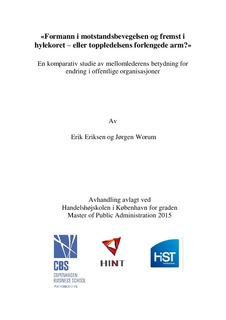| dc.description.abstract | Denne avhandlingen er basert på en undersøkelse av offentlige organisasjoner som drives
døgnet rundt. Det som er undersøkt er hvilken betydning det har for endring i en organisasjon
at det er en leder med personalansvar på jobb samtidig med de ansatte.
Undersøkelsen er gjennomført som en komparativ analyse av to caser der det er brukt
kvalitativ metode ved intervju av 11 ansatte i Levanger kommune og Oslo politidistrikt. Vi
har undersøkt forskjellen mellom en organisasjon der leder og ansatte arbeider samtidig og en
organisasjon der leder arbeider dagtid mens de ansatte arbeider turnus. Gjennom
undersøkelsen har vi forsøkt å svare på problemstillingen: Øker muligheten for å lykkes med
endring i døgndrevne offentlige tjenester ved nærvær av leder?
De sentrale teoriene som er benyttet i analysen er teori om strukturelle organisasjoner,
ledelsesteori med teori om distanse mellom leder og ansatt og ulike lederroller, maktteori,
teori omkring forskjellige typer problemer og prinsipal-agentteori.
Hovedresultater er at leder som arbeider sammen med de ansatte øker muligheten til å utvikle
et felles språk, løse problemer og forebygge opportunisme.
Spesielt har man ved å være til stede sammen med de ansatte muligheten til å kunne utvikle
en felles fortolkning av informasjon og påvirke kommunikasjonen i den retning man ønsker.
Profesjonsmedarbeidere løser de fleste profesjonsspesifikke problemer på egenhånd, men
leder er viktig for å løse de mer generelle problemer. At leder arbeider samtidig med de
ansatte gjør at man hele tiden kan håndtere konflikter, korrigere adferd og allokere ressurser. I
motsatt fall må dette ofte håndteres i ettertid, hvilket tar mye av lederens tid og ressurser.
At leder og ansatt arbeider samtidig er spesielt viktig for å hindre asymmetrisk informasjon.
Det gir også leder mulighet til å hindre ulikheter i målstruktur og konsekvenser som følge av
ulik risikoaversjon. Ønsker man endring bør man fokusere like mye på det første som det
siste.
Leder som arbeider samtidig med de ansatte kan ha stor betydning for evnen til endring i en
organisasjon. Det hele avhenger imidlertid av hvilken rolle lederen inntar. Om han ser på seg
selv som nettopp leder vil han kunne være en viktig endringsagent. Men ser han på seg selv
om en «fremst blant likemenn» er det grunn til å tro at han heller vil virke hemmende på
endring.
This thesis is based on a study of public organizations operated around the clock. What is
researched is the impact it has for change in an organization that a leader with responsibility
for personnel works simultaneously with the employees.
The survey was conducted as a comparative analysis of two cases where it is used qualitative
method when interviewing 11 employees in Levanger municipality and Oslo police district.
We have investigated the difference between an organization where the leader and staff is
working simultaneously and an organization where the leader is working day while the staff is
working shifts. Through the study we have tried to answer the question: Increases the chance
for successful change in day-run public services if the leader is present?
The central theories used in the analysis is theory of structural organizations, management
theory including theory of distance between manager and employee and various leadership
roles, power theory, theory about different types of problems and principal-agent theory.
Main results are that a leader who works with the staff increases the opportunity to develop a
common language, solving problems and prevent opportunism.
Specifically, working together with the employees strengthens the opportunity to develop a
common interpretation of information and affect communication in the direction you want.
The professional solves most profession specific problems on their own, but the leader is
important to solve the more general problems. A leader working simultaneously with the staff
has the possibility to constantly handle conflicts, correct behavior and allocate resources.
Otherwise, this is often handled in hindsight, which takes much of the manager's time and
resources.
When it comes to preventing opportunisms leader and employee working simultaneously is
particularly important to prevent asymmetric information. It also gives managers the
opportunity to prevent differences in the goals and consequences of different risk aversion.
Our research showed that if you want change you should focus equally on the first as the last.
Leader working simultaneously with the employees can have great significance for the ability
to change in an organization. It all depends, however, what role the leader occupies. If he sees
himself as a leader he will be an important change agent. But he looks at himself as a “first
among equals” there is reason to believe that he would rather impede the change. | nb_NO |
